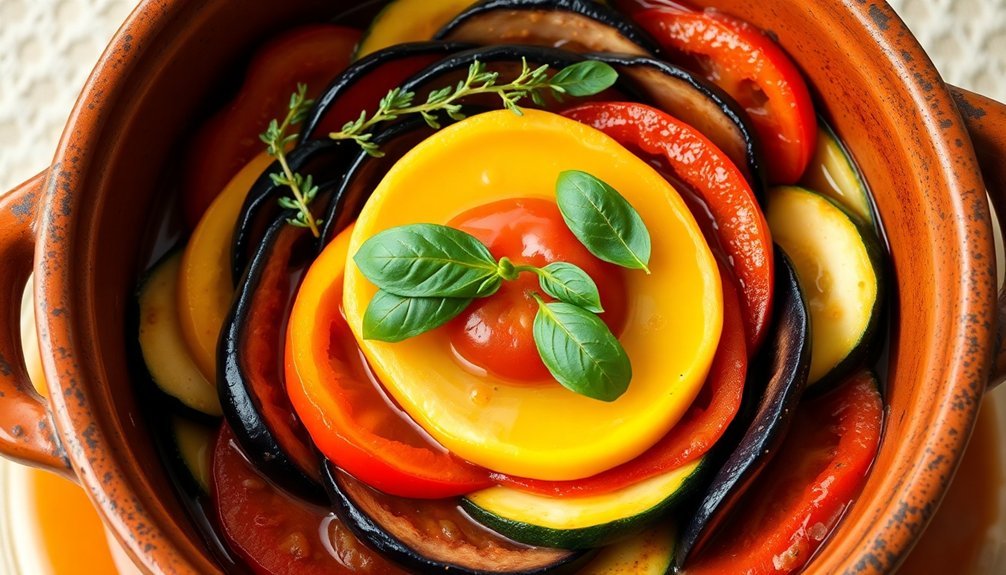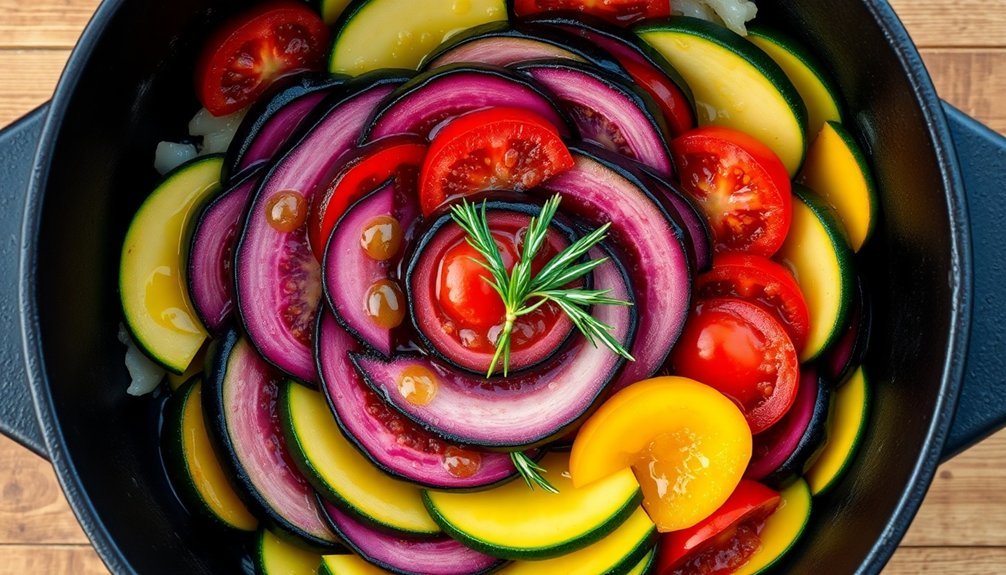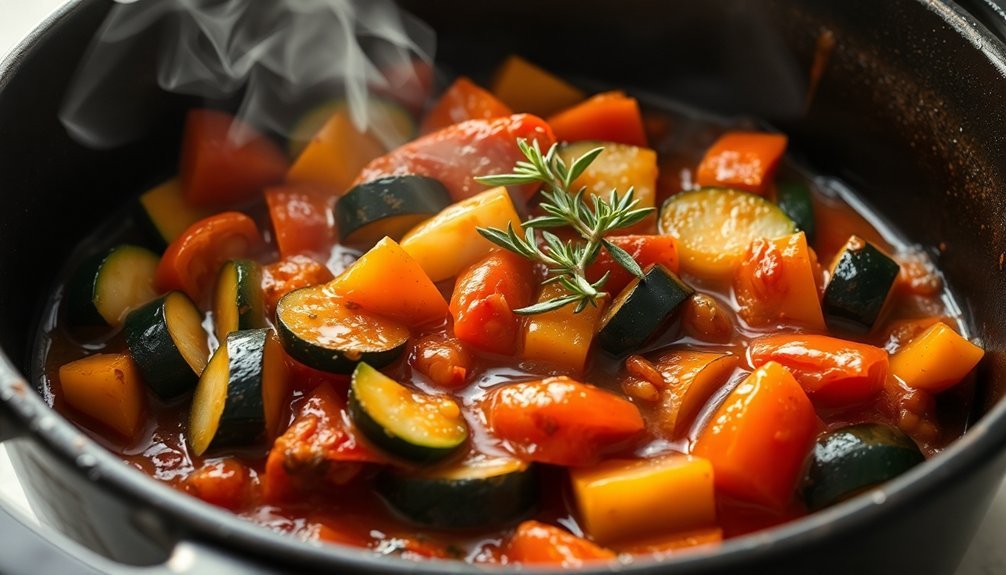You'll create the perfect Mediterranean ratatouille by layering fresh vegetables in a solar cooker for an eco-friendly twist on this classic dish. Start with sautéed onions and garlic, then add uniform 1-2 inch cubes of eggplant, zucchini, and bell peppers. Layer ripe tomatoes as your base, arranging additional vegetables in a circular pattern. Cook at 200-220°F for 60-80 minutes in your solar setup, ensuring proper sun alignment between 11 am and 3 pm. Let it rest for an hour before serving at room temperature with crusty bread. Discover how this traditional one-pot meal transforms into a sustainable culinary adventure.
Essential Ingredients For Mediterranean Ratatouille

At the heart of every authentic Mediterranean ratatouille lies a vibrant collection of fresh vegetables and aromatic seasonings.
You'll need ripe tomatoes, preferably beefsteak or heirloom varieties, along with cubed eggplant, young zucchini, and colorful bell peppers. A generous portion of chopped yellow onions forms the dish's aromatic base.
The seasoning blend is equally important to achieve that classic Mediterranean flavor.
You'll want to include 3-4 minced garlic cloves, fresh basil (added at the end), and sprigs of thyme. A bay leaf and red pepper flakes can add extra depth and heat if you're looking to enhance the taste profile. The dish becomes more flavorful when allowed to cool and reheat.
For the cooking medium and additional flavoring, you'll need high-quality extra-virgin olive oil.
Some variations call for tomato passata or a splash of red wine vinegar to intensify the tomato essence. Don't forget salt and freshly ground black pepper for proper seasoning.
If you're looking to add more Mediterranean flair, you can incorporate capers, black olives, or a traditional persillade spice mix.
These optional ingredients will give your ratatouille a more complex and authentic character.
Preparing Your Solar Cooking Setup
Now that you've gathered your fresh Mediterranean ingredients, let's prepare the solar cooking setup that will transform them into a splendid ratatouille.
Start by unfolding your solar oven and confirming the ventilation flaps sit at the bottom for proper airflow. Connect the support rods by joining their halves, then position your oven in a sunny spot. You'll want to set up between 11 am and 3 pm for maximum sunlight exposure.
Stand behind the oven and align it directly with the sun – you'll know it's properly positioned when the shadow falls straight behind it. Use the reflective surfaces to concentrate sunlight onto your cooking chamber, and make certain there aren't any shadows inside the cooker. Place a wire rack inside to improve heat circulation under your pot during cooking.
Begin preheating at least an hour before you plan to cook your ratatouille. Keep the cover zipped throughout the entire process, only opening it when you need to add or check your ingredients.
You'll need to monitor the temperature regularly and adjust the reflectors as needed. Remember to reposition your oven periodically to maintain direct sunlight exposure, as this will guarantee your ratatouille cooks evenly and thoroughly.
Layering Vegetables For Perfect Results

Getting the vegetable layers right in your Mediterranean ratatouille makes all the difference between a good dish and an exceptional one. Start by cutting your vegetables into uniform 1-2 inch cubes, ensuring you've selected fresh, ripe tomatoes, young zucchini, and globe eggplants. Don't forget to peel or stripe the eggplant to reduce bitterness.
Begin your layering process by sautéing onions and garlic as your flavor base. Add bell peppers and cook until they're soft before introducing other vegetables. You'll want to create a foundation of tomatoes and their juices, mixed with herbs and spices, before adding the eggplant and zucchini. When prepared properly, leftovers taste even better as the flavors continue to develop over time.
For a visually stunning presentation, use a mandoline to slice your vegetables thinly and arrange them in a circular pattern in your skillet. First, spread a layer of tomato sauce, then alternate your sliced vegetables on top.
Cover your pot to trap heat and juices while cooking. Remember to maintain texture by cooking zucchini until it's slightly crunchy and eggplant until it's tender but not mushy. Add fresh herbs at the end for bright flavor.
Solar Cooking Time And Temperature
Solar cooking offers a sustainable way to prepare your Mediterranean ratatouille while harnessing natural energy. Since solar cooking typically operates at lower temperatures than traditional methods, you'll need to adjust your cooking times accordingly. Based on conventional cooking temperatures, aim for your solar cooker to reach between 200-220°F for ideal results.
| Time of Day | Solar Temperature | Cooking Stage |
|---|---|---|
| Morning | 180-200°F | Initial vegetable softening |
| Midday | 200-220°F | Primary cooking phase |
| Afternoon | 190-210°F | Slow simmer completion |
| Evening | 170-190°F | Natural rest period |
You'll want to start your ratatouille early in the day when solar intensity is building. Layer your vegetables as you would in traditional methods, but expect cooking times to extend by 1.5 to 2 times longer than stovetop cooking. Monitor your vegetables closely – they should become tender over 60-80 minutes of solar cooking. Add your liquid ingredients gradually to maintain moisture, and don't forget to adjust seasonings near the end of cooking. You can tell your ratatouille is done when the vegetables are soft and the flavors have melded together.
Achieving The Right Consistency

The perfect ratatouille balances delicate textures with a rich, stew-like consistency that showcases each vegetable's unique character. You'll need to carefully manage the cooking process to achieve this ideal texture, whether you're using a one-pot method or cooking vegetables separately.
If you're opting for the one-pot technique, start by sautéing onions and garlic to build your flavor base. Add your vegetables in sequence, considering their cooking times, and remove the lid after initial boiling to help reduce excess liquid. You'll want your tomatoes to break down while maintaining some texture in your zucchini, eggplant, and bell peppers.
For best results, consider roasting your vegetables before combining them with the tomato base. This method caramelizes the vegetables and removes excess moisture, preventing mushiness in your final dish.
Use two separate baking sheets to control cooking times for different vegetables. Once roasted, you'll combine them with your simmering sauce, allowing the flavors to meld while maintaining distinct textures.
Remember to reduce the liquid until you achieve a stew-like consistency, but don't overcook – you want tender vegetables that still retain their individual character.
Serving And Storage Methods
You'll get the best flavor from your ratatouille when served just warm, allowing the dish to rest in its pot for about an hour after cooking.
For storage, opt for non-plastic, airtight containers to protect against tomato acidity, and keep your leftovers fresh in the refrigerator for up to 4 days.
When reheating, warm the ratatouille gently on the stovetop with a splash of vegetable broth to maintain its perfect consistency.
Optimal Temperature For Serving
Discovering the ideal serving temperature for Mediterranean ratatouille can enhance your dining experience considerably.
You'll find that room temperature is often the sweet spot, allowing the complex flavors to fully develop and shine. Let the dish rest for about an hour before serving to achieve this perfect balance.
If you're craving something warmer, you can gently heat your ratatouille, especially when you're planning to top it with a sunny-side-up egg.
For summer gatherings, don't hesitate to serve it cold – it's remarkably invigorating and convenient for outdoor meals.
Whatever temperature you choose, avoid the extremes, as they can compromise both flavor and texture.
You'll want to give the ingredients time to meld together properly.
- Savor the natural sweetness of vegetables at room temperature
- Experience the comforting warmth with crusty bread for dipping
- Enjoy the convenience of cold servings for casual outdoor dining
- Appreciate how the flavors deepen when properly rested
- Discover the versatility of serving options for any occasion
Remember that your ratatouille shouldn't be scorching hot or ice cold – these temperatures can mask the delicate flavors you've worked so hard to develop.
Storage Container Best Practices
Selecting proper storage containers for your ratatouille guarantees optimal freshness and flavor preservation. For ideal storage, you'll want to use glass containers with airtight lids, as glass is non-reactive and won't affect the taste of your acidic tomato-based dish. If you're planning to freeze portions, make sure your containers are freezer-safe and leave about an inch of headspace for expansion.
| Container Type | Best For | Duration |
|---|---|---|
| Glass Container | Refrigeration | 3-4 days |
| Stainless Steel | Short-term | 1-2 days |
| Freezer-safe Glass | Long-term | 2-3 months |
| Ceramic | Serving/Short-term | 1 day |
Always label your containers with the date you made the ratatouille and its expected use-by date. Don't store your ratatouille in plastic containers, as the acidic ingredients can react with the material and affect both taste and food safety. When transferring leftovers, make sure your storage containers are thoroughly cleaned and sanitized. If you're meal prepping, consider portioning your ratatouille into individual servings before storage – this makes reheating easier and helps prevent repeated temperature fluctuations that can affect quality.
Leftover Reheating Tips
When reheating leftover ratatouille, choosing the right method guarantees you'll maintain its original texture and flavors while keeping the vegetables from becoming mushy.
The stovetop offers precise control – simply transfer your dish to a saucepan, cover it, and heat on medium while stirring occasionally. If you're reheating a larger portion, the oven method at 300°F works well, just remember to cover with foil and stir halfway through.
For quick reheating, your microwave can do the job in 1-2 minutes. Just verify you're using medium power and stirring halfway through. If you've frozen your ratatouille, don't rush the thawing process – let it defrost in your refrigerator for 8-12 hours before reheating.
- You'll know your ratatouille's perfectly reheated when steam rises gently from the dish
- Your vegetables should maintain their distinct shapes, not turn to mush
- The sauce should be bubbling slightly around the edges
- The aroma should remind you of that first fresh-cooked batch
- The internal temperature should reach 165°F for safe eating
Remember to add a splash of water or extra sauce if your ratatouille seems dry during reheating, regardless of your chosen method.
Frequently Asked Questions
Can I Substitute Mediterranean Vegetables With Non-Mediterranean Alternatives?
You can definitely swap Mediterranean vegetables with alternatives! Use carrots instead of eggplant, add mushrooms for texture, or include beans for protein. Just maintain key flavors with herbs like herbes de Provence and garlic.
How Do Traditional French and Mediterranean Ratatouille Recipes Differ?
You'll find Mediterranean ratatouille uses quicker one-pot cooking and brighter spices, while traditional French versions require individual vegetable searing, longer cooking times, and focus on deep, slow-developed flavors with classic herbs.
Does Cutting Vegetables in Different Shapes Affect the Final Taste?
Yes, the way you cut vegetables greatly affects their taste. You'll get more intense flavors from finely chopped pieces due to increased enzyme release, and different cuts impact how vegetables absorb seasonings and cook through.
Can I Prepare Ratatouille Ingredients the Night Before Cooking?
Yes, you can prep most ingredients the night before. Chop and store onions, garlic, and peppers in separate containers. Salt eggplant to drain, but leave tomatoes until cooking day for best results.
Why Does My Ratatouille Sometimes Turn Bitter After Cooking?
Your ratatouille's bitterness likely comes from mature eggplants containing more alkaloids and seeds. You'll get better results using younger, smaller eggplants and Italian or Japanese varieties instead of large globe eggplants.
In Summary
You'll find this solar-cooked Mediterranean ratatouille becomes a family favorite with its perfectly layered vegetables and rich flavors. Remember to store your leftovers in an airtight container for up to 4 days in the fridge. For the best results, let it sit for 30 minutes after cooking to allow the flavors to meld before serving. Don't forget to pair it with crusty bread or your favorite grain.





Leave a Reply